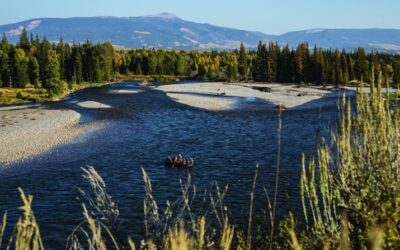It was a frosty morning in March and employees and volunteers from the Teton Raptor Center were lugging special cargo from the barn. They walked gingerly across the gravel lot, placed a large animal carrier onto the snow-blanketed field, and unlatched the door. A small group of spectators stood in silent awe, some with tears welling in their eyes, as a 30-year-old bald eagle was released back into the wild, its wings flapping with wide majesty through a cloudless blue sky.
Among the people watching the rehabbed bird’s release was Reed Moulton.
Six weeks earlier that ancient eagle—one the oldest known bald eagles living in the wild— crashed through Moulton’s window of his Hoback cabin. He was laying in bed with his dog Rosie when he heard a thunderous noise.
“This is terrifying!” Moulton exclaimed in a video he filmed after the bird’s crash landing. “Oh my god, he’s flapping around in there. What do you do in a situation like this?”
Folks at Teton Raptor Center knew just what to do. Rehabilitation director Meghan Warren marched into Moulton’s bedroom. The bird was perched on Moulton’s desk amid the crash scene—broken glass everywhere. The eagle was “quite spirited,” Warren said. It flapped its wings, scrambled back and forth, and edged towards the broken window. Warren, worried it would cut itself, moved quickly, grabbed it by the legs and got the bird “under control,” though the eagle did try to bite her in the process.
Back at the Teton Raptor Center, where they already had a full house of roughly 20 birds to rehabilitate, Warren and her team nursed the eagle for weeks. The raptor was relatively unscathed but it did have some abrasions on its eye, wings and feet and spent time recuperating in the TRC’s special oxygen chamber. Meanwhile, staff injected the bird with saline fluid and medicine to rid its blood of lead. Warren said lead poisoning is a common ailment for eagles here. They scavenge on carcasses left by hunters and consume the lead from bullet particles. Sometimes the poisoning is acute and other times it builds up in the birds’ systems over time.
Warren said that build up becomes dangerous when the eagles experience a stressful event, like migration. When they use more energy and tap into their fat reserves, the lead then leaches back into their bloodstreams and the raptor center sees a spike in poisoned birds.
As for this ancient eagle? Warren said they couldn’t pinpoint the origin of the bird’s poisoning but overall, the bird was relatively healthy, “it just happened to crash through a window.”
To learn the eagle’s age, that it is one of the oldest living in the wild, staffers researched the number on its banded ankle. The initial message that came back from the bird banding lab at the United States Geological Survey read, “You either have an usually old bird or there’s a mistake with the number.”
After more research, they discovered the bird was born in 1989. That’s an anomaly—most eagles live on average 20 years in the wild. But these birds tend to thrive in the Greater Yellowstone Ecosystem, said Teton Raptor Center’s education director Becky Collier. She remembered a 34-year-old eagle that the Teton Raptor Center admitted in 2016 after it was electrocuted by a power line.
When they took that eagle outside for fresh air and sunshine, Collier noticed something peculiar: the bird would call to other bald eagles who obliged her and flew low. In other words, this eagle lived long enough to probably have a huge family and a key impact on the species.
We know the age of these ancient eagles thanks to biologists that banded the birds in the 1980s. It was part of an effort to help aid their recovery. At the time, bald eagle populations were declining due to widespread DDT use, the Fish and Wildlife Service notes. Before it was outlawed in 1972, DDT was widely used as a pesticide, washing into waterways and contaminating plants and fish. Bald eagles were poisoned with DDT when they ate those fish and the chemical weakened the birds’ eggshells.
Ultimately, the raptor center had to put down the 34-year-old eagle after its health took a notable decline. But In 2016 following its euthanization, the Teton Raptor Center launched a genetic study on bald eagles to trace how these old raptors are influencing the recovery of an endangered species.
“As a result of that 34-year-old bird, after she passed, we all sat down and thought, OK, that was an amazing bird and that bird deserves for her story to not end,” Collier said.
The research team at Teton Raptor Center has become the author of that eagle’s story, banding her offspring and studying the impact she has had on her species. And that gives Collier solace. What also gives her solace is the image on that recent March morning of the 30-year-old eagle, successfully rehabbed, flapping its wings and making its way back into the wild.





